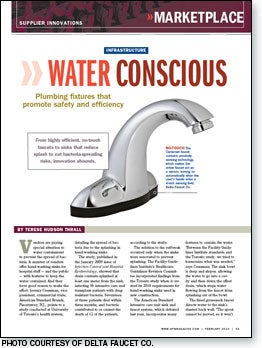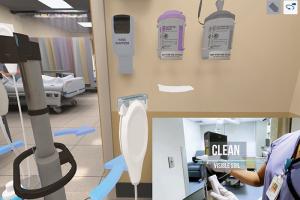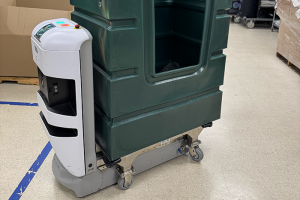Water conscious
 Vendors are paying special attention to water containment to prevent the spread of bacteria. A number of vendors offer hand-washing sinks for hospital staff — and the public — with features to keep the water contained. And they have good reason to make the effort. Jeremy Cressman, vice president, commercial trade, American Standard Brands, Piscataway, N.J., points to a study conducted at University of Toronto's health system, detailing the spread of bacteria due to the splashing in hand-washing sinks.
Vendors are paying special attention to water containment to prevent the spread of bacteria. A number of vendors offer hand-washing sinks for hospital staff — and the public — with features to keep the water contained. And they have good reason to make the effort. Jeremy Cressman, vice president, commercial trade, American Standard Brands, Piscataway, N.J., points to a study conducted at University of Toronto's health system, detailing the spread of bacteria due to the splashing in hand-washing sinks.
The study, published in the January 2009 issue of Infection Control and Hospital Epidemiology, showed that drain contents splashed at least one meter from the sink, infecting 36 intensive care and transplant patients with drug-resistant bacteria. Seventeen of those patients died within three months, and bacteria contributed to or caused the death of 12 of the patients, according to the study.
The solution to the outbreak occurred only when the sinks were renovated to prevent splashing. The Facility Guidelines Institute's Healthcare Guidelines Revision Committee incorporated findings from the Toronto study when it created its 2010 requirements for hand-washing sinks used in new construction.
The American Standard intensive care unit sink and faucet system, which debuted last year, incorporates many features to contain the water. "Between the Facility Guidelines Institute standards and the Toronto study, we tried to harmonize what was needed," says Cressman. The sink bowl is deep and slopes, allowing the water to go into a cavity and then down the offset drain, which stops water flowing from the faucet from splashing out of the bowl.
The fixed gooseneck faucet directs water to the sink's slanted back wall. "The spout cannot be moved, so it won't kick up mold or mildew," notes Cressman.
The sink also has a sensor allowing for touchless operation. Both the water flow and the sensor can be adjusted, and the laminar flow device doesn't allow air to be drawn into the water stream. In another feature to stop the spread of pathogens, the sink can include an auto-purge function. This allows users to program the faucet to open periodically to purge the faucet and water lines of stagnant water. Cressman adds that American Standard considered manufacturing the sink from such materials as a solid-surface polymer, stainless steel or vitreous china. "The china was the most durable of the three," explains Cressman, adding that a china sink could be manufactured more easily and less expensively than the others, making it the top choice.
Water containment also has become a point of emphasis for public lavatories. Bradley Corp., Menomonee Falls, Wis., has introduced a washroom sink that incorporates touchless soap, faucet and a hand washer in one unit. The Advocate AV-series sink, introduced in November, creates a left-to-right motion for the user, with automatic dispensing of soap, water and a dual-sided hand dryer. The dryer portion includes LED lighting so users can keep their hands away from the sides of the dryer cavity.
"This makes the whole process truly touchless," says Will Haas, Bradley manager of patient care products. He notes that the product has a number of advantages over the traditional sink and adjacent hand dryer or paper towels. "Water that drips on the floor is a breeding ground for bacteria and is a slip hazard," Haas notes. "Because users are not going to another location for paper towels or a hand dryer, the floor stays dry." With everything in one unit, plumbing and electrical connections can be simplified and designers don't have to coordinate the separate accessories. The unit comes standard in a .38 gallon-per-minute water flow, something customers have requested to conserve water and as a way to attain LEED contributing points, says Haas.
Automating faucets
Electronic faucets are increasingly in greater demand, says John Fitzgerald, vice president of marketing for Chicago Faucets, Des Plaines, Ill. "In the plumbing industry, sales of electronic faucets have grown every year over the last six years." Fitzgerald credits this sales growth to three developments: the overall improvement in reliability, the trend to want to conserve water and the decreasing price of electronic technology. "The spread between the cost of an electronic faucet and a manual one is shrinking," he says.
Perhaps another reason for the growth in electronic faucets is the myriad operational choices it affords facility managers. For instance, the sensor on American Standard's hand-washing sink can be set to three different functions: It can run water as long as hands are under the faucet; it can be set for a certain amount of time, encouraging clinicians to scrub hands as long as the water is flowing; or it can be set to be turned on and off with hand presentation under the faucet. "Facilities can tailor this sink's operation to each site's preferred use," says Cressman.
Even with the increased use of electronic faucets, some manufacturers incorporate low-tech redundancies. To build in reliability, some faucets offered by Moen Commercial have a manual override in case the battery runs low, notes Jeff Wells, senior product manager at Moen Commercial, North Olmsted, Ohio. Redundancies like this are important because hospitals have to operate consistently 24/7, says Larry Rains, senior plumbing designer with Smith Seckman Reid Inc., Nashville, Tenn., and it's not likely that a hospital would want the expense of connecting lavatory faucets to an emergency generator.
Fixtures go upscale
Experts say they see a decided trend toward more upscale fixtures in patient bathrooms. Many hospitals are choosing matte finish on plumbing fixtures for a more residential feel. Kristin Kahle, vice president at Whitehall Manufacturing, City of Industry, Calif., points to Whitehall's patient care units with cast resin tops, often used in critical care units, making them look less institutional. That same counter top shows flexibility, as it can be lit from the inside for use as a night-light or for viewing X-rays.
Another trend spotted by vendors is the complete shower system. "It's essentially a bathroom in a box," says American Standard's Cressman, adding that the kit includes faucets, fixtures, flush valves, acrylic composite shower walls and a shower system. It also comes in 25 colors and can be designed to any type of finish. Although there are no tile and grout, the solid-surface walls can look as if there are. "If a bathroom is gutted, the contractor has a complete replacement kit, all the pieces there at one time all manufactured to fit together." By buying everything together, health facilities can save money and labor costs during installation.
In the future, Cressman predicts that health facilities will purchase more bathrooms built off-site in "pods" because the nation will have a trade labor shortage. In this operation, the workers can build the bathroom at an assembly site and save hospitals on construction schedule costs. "You slide the modular bathroom into place and work around it," Cressman adds. Companies such as Eggrock Modular Solutions, Littleton, Mass., manufacture such bathrooms for health care settings.
High-tech maintenance
Maintenance is a significant cost of plumbing fixtures, and vendors continue to search for ways to lessen this burden, both in cost and facility staff hours. Late last year, Chicago Faucets released its own handheld tool that works with its Commander software to allow staff on the move to have information easily accessible. The software-enabled handheld device, which works to maintain Chicago Faucets' HyTronic and E-Tronic faucets, allows the user to change such settings as sensing range and flow times automatically and to check the battery level.
Fitzgerald notes that this last function can generate savings, because batteries aren't needlessly replaced when they still have hours of service left. And because the Commander software can run diagnostics on the faucets, it may lead to greater savings. "The software allows maintenance personnel the opportunity to understand faucet usage and make necessary adjustments to the faucets, as opposed to replacing them," says Fitzgerald.
The company chose to create its own handheld device because the popular mobile platform continues to change. The Commander software first was released in 2005, and was compatible with Palm personal digital assistants. Says Fitzgerald, "We started looking at updating our mobile device four years ago when the Blackberry was dominant and the first iPhone was a year old. As technology evolves, we did not want to be tied to a platform we did not control." By creating its own device, the company could give it the features that would help a plumber: a big touchscreen that needs no stylus and a rugged case that can be thrown into a toolbox.
Health care to grow
Fitzgerald and other vendors expect health care to be a growing sector of the market for their products. "Health care is an extremely important segment for us. The population is older and we are living longer," he says. "Health care will continue to grow."
And facility managers can expect more products to meet their needs. "Is there innovation coming? I'm sure there is," says Rains.
Terese Hudson Thrall is a freelance health care writer based in Homewood, Ill., and former associate editor for Health Facilities Management.
| Sidebar - For more information |
| For further details on the plumbing products discussed in this month's "Marketplace" article, readers can contact the following vendors: »American Standard Brands »Bradley Corp. »Chicago Faucets »Delta Faucet Co. »Moen Commercial »Waterless Co. »Whitehall Manufacturing |




